#techniques et architecture
Explore tagged Tumblr posts
Text
5 Techniques pour la Photo Noir et Blanc
L’Art de la Photographie Noir et Blanc : 5 Techniques Essentielles 5 Techniques pour la Photo Noir et Blanc La photographie en noir et blanc transcende la simple absence de couleur pour capturer des contrastes, des textures et des formes d’une manière qui interpelle l’émotion et l’imagination. C’est une expression artistique qui exige une compréhension fine des nuances de gris, du jeu entre…

View On WordPress
#Contraste#forme#Ombre#photographie abstraite#photographie architecture#Photographie de rue#photographie noir et blanc#photographie paysage#photographie portrait#techniques photographie#Texture#ton#vision en tonalités
0 notes
Text
"Ryuurin, Hanpatsu, Tsugai no Ryuusei" -- the incantation for World Slash, and an epitaph to Gojo Satoru.

In JJK, incantations are supposed to boost power of a particular technique. When Sukuna used World Slash to kill Gojo, he imposed a binding vow that allowed him a single-use activation without the requirement of a hand sign, in exchange for using incantations and directing the attack for all subsequent uses.
In this post I'll examine the specific phrases in Sukuna's incantation and argue that each phrase of the incantation corresponds to an application of Gojo's Limitless technique. Then I'll briefly relate this to the binding vow requirements to argue that Sukuna's promise to never forget Gojo for the rest of his life is one of the conditions of that binding vow.
1. "龍鱗"
First, "ryuurin" (dragon scales) describes the basic application of Limitless, a strong defensive barrier like the scales of a dragon. This one is the most obvious, hinted at by Sukuna's words at the beginning of the fight, telling Gojo he plans to "strip away his scales." More will be said about the dragon references, in the discussion of the third phrase.

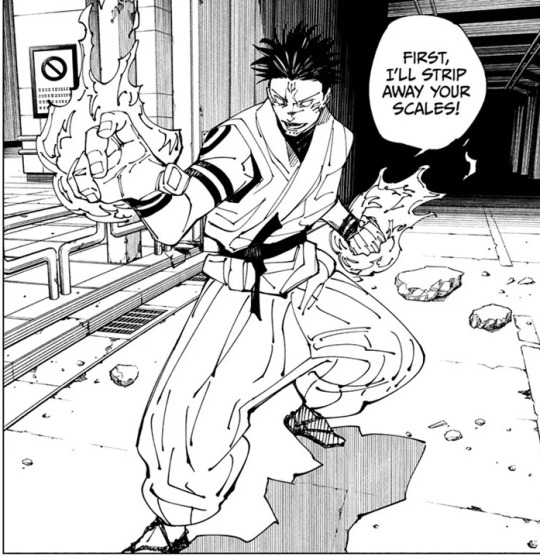
Less relevant but still interesting - there’s also a Buddhist reference here, according to this forum post:
At surface, straight value, it is just the literal scales of a dragon. The word can also be used to mean "a large quantity of things". Ryurin is also a metaphor for the power/authority/influence of heroes and of the Heavenly People (the residents of the Japanese version of the Devaloka, where devas and gods reside. Just a heavenly realm, basically.) Lastly, Ryurin means a dangerous condition/situation or a dangerous thing. So. For Sukuna, its basically 'dangerous divine power/authority'.
2. "反発"
Next, "hanpatsu." Hanpatsu means recoil, which is the equal and opposing force of an action. This describes Purple, which is the rebounding damage created by the collision of Red and Blue. At first I thought hanpatsu described Red, because Red is a “repulsing” force. Except “recoil” is not the same thing as repulsion. Another possibility was that hanpatsu described the relationship between Red and Blue — Red as the “equal and opposite” of blue, and vice versa. But we know the two aren’t equal in power, and neither technique is accurately described as the “recoil” or rebounding force produced by the other.
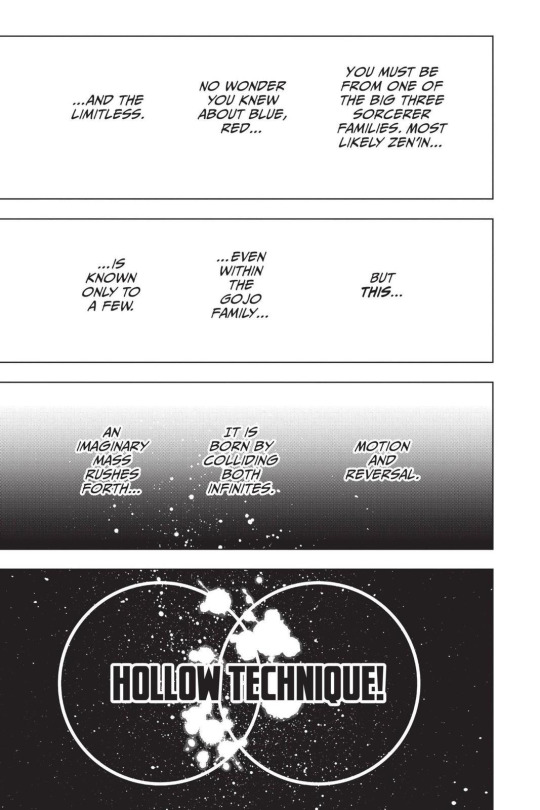
3. "番いの流星"
Finally, "tsugai no ryuusei." A few things here. First, the wordplay and translation. Like ”Ryuurin”, this term references dragons. Here Ryuusei, meaning meteor or comet, is also pun on the word dragon, ryuu (which isn’t novel, see the Japanese word for Pokémon move Draco Meteor, et al.). So a plausible English translation could also be “Twin Dragon Meteors.” Second, how dragons are relevant to Sukuna’s mythology. In Hida, there is a temple Senkoji said to be founded by “Ryomen Sukuna … approximately 1,600 years ago. A central architectural feature of the temple it Dragon Ceiling, a portrait of two dragons painted by Kano Tansetsu on the ceiling of the main buliding. From the website,
According to temple legend, a general of the Sengoku period committed suicide there by seppuku, staining the floor with blood. For the repose of general’s soul, the floorboards were incorporated into the ceiling of the main temple. Some time later, Kano Tansetsu visited Senkoji and painted the dragons on the ceiling. At Senkoji, the objects of worship include not only the main temple and the priest’s quarters, but also the entire temple complex.
According to this Reddit post, the temple’s founding tale describes how Sukuna fought off a dragon god living in the mountain and built a shrine in its place. So — from the fact that dragons are the mythological enemy of the figure Ryomen Sukuna, we may infer that the words of the incantation refer to an enemy or target of the World Slash technique.
What could "twin meteors" refer to other than the related techniques of Limitless, the twin floating spheres Red and Blue?
Another potential connection to Red/Blue rooted in dragon mythology is the tide jewels — the tide-ebbing (a repelling force, like Red) kanju and tide-flowing (an attracting force, like Blue) manju, possessed by Ryuujin, the Sea King.
The final reason I think the incantation refers to Gojo’s technique is because of Sukuna’s explanation in 236 for World Slash — he describes the process of developing the technique as figuring out how to target Limitless with Dismantle. So it makes sense that the incantation to power World Slash operates by describing its target, not World Slash itself.
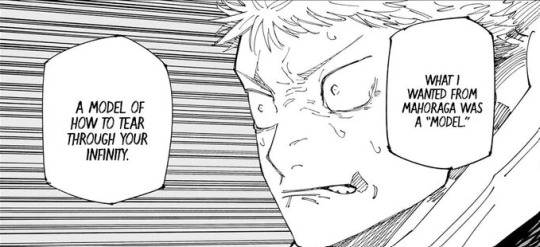
It also lends significance to the order of the incantation — first visualizing the most generalized application of Limitless (ryuurin), then passing through Purple (hanpatsu) to finally arrive at two separate applications, Red and Blue (tsugai no ryuusei) — a conceptual "bisection" of Limitless into two discrete components.
4. Binding Vows
Isn't this pretty romantic? But wait there's more. We know now after Chapter 255 that in exchange for unleashing the World Slash that killed Gojo without using the hand sign, Sukuna now has to recite the incantation every time (+using the hand signs and directing the attack with his palm) he uses World Slash.
Assuming what I've previously argued is true (the incantation describes Gojo's Limitless), this gives Sukuna's last words to Gojo another layer of significance. When Sukuna tells Gojo he will never forget him, it's not just an expression or a promise, but a statement of the binding vow Sukuna has to make in order to land the killing blow. In other words, the cost of killing Gojo is having to remember him forever, to integrate him into Sukuna's own technique through a verbal invocation that must be made every single time Sukuna uses the world bisecting slash. Yeah, that's pretty romantic.

#ryomen sukuna#gojo satoru#sukugo#A love which bisects the world. truly this is our sukugo kaisen#jjk meta#jjk#jujutsu kaisen#jujutsu kaisen meta#idk what else to tag this as#binding vows#?#jjk analysis#pardon some of the writing here this was originally a text msg I sent to a friend#it’s a very wordy outline pretending to be an essay
412 notes
·
View notes
Text
tagged by @atthecenterofeverything to list 10 books im planning to read next yayyyyy. i actually revise my tbr in my head every five seconds so this is vibes based and i make no promises <3
Doctor Glas by Hjalmar Söderberg -- i reread Love in the Time of Cholera recently and discovered i disagree with my taste at the age of 16 💔 but i love reading about fictional doctors so ive been tearing thru some of those and this is next on the stack
Necropolis by Basil Copper -- also teed up from ^ this batch
Le Berceau des dominations - Anthropologie de l'inceste par Dorothée Dussy -- recced by a friend, looks really great even though i SAID i need to read more fiction in french bc it really is better practice for variety of phrasing lol
The Purchase of Intimacy by Viviana A. Zelizer -- also recced by a friend, has been on my mental tbr for a few months, related to some things ive been chewing on lately
Querelle de Brest par Jean Genet -- I loved the fassbinder adaptation the only question is when will i be brave (patient) enough to tackle genet in french lol
L'art et la matière: Les artisans, les architectes et la technique, 1770–1830 par Valérie Nègre -- nobody look at meeee it's not fiction again but i read either one book or multiple papers by paola bertucci about the contemporaneous formation of the categories of artiste vs artisan vs savant & that one focusses more on the intellectual production side but this one i think is more what i want in terms of. i like to look at buildings and understand why they look how they look
Kara Kitap by Orhan Pamuk -- just been on my list for a hot minute, i loved my name is red
Un enfant à l'asile. Vie de Paul Taesch par Anatole Le Bras -- i think this is going to be bad tbh but it's 19th century child in an asylum in the rare case in which the author isn't having to 100% read the archive backward so i rly can't resist
Madness, Architecture and the Built Environment: Psychiatric Spaces in Historical Context (edited vol.) -- edited volumes are rarely very good & i think the scope is too wide here but the topic is one ive been meaning to get more granular on since i read sun-young park on the architecture of paris deaf-blind institutes so i'm at least going to use it to get more oriented in this sub sub field of lit
Poisoned Eden: Cholera Epidemics, State-Building, and the Problem of Public Health in Tucumán, Argentina, 1865-1908 by Carlos S. Dimas -- the paris cholera epidemics following the 1830 and 1848 revolutions are so rich for historical analysis and i stumbled across this book recently working with some of the overlapping public health–politics concerns in argentina, looks great can't wait
i have noooo idea who's already done this or who wants to lol but if you see this please do it and tag me i get so many reading recs off random tumblr posts xx
35 notes
·
View notes
Text
If you struggle with spaceship/mech/sci-fi architecture design...
There's a very effective technique for designing spaceships, mechs, and sci-fi architecture that many people use, but also many people don't know about:
Step 1: Look at some regular thing nearby, like a razor, bottle, bug, seed pod, et cetera. Step 2: Picture it as a begreebled spaceship, mech, or building.
If you need examples, artist space gooose does this.
("Wait a moment, how does this work for a mech, when most stuff isn't human-shaped?" - you just make it the head or body and work from there. "What if it's asymmetrical?" Then so much the better - if Pacific Rim taught us anything, a little asymmetry on a mech can be a good thing.)
#science fiction#sci fi#mechs#mecha#spaceship#spacecraft#spaceship design#mech design#mecha design#pacific rim#jaegers#jaeger#jaeger tech
29 notes
·
View notes
Text
Dacia frappe fort avec son nouveau SUV équipé d’un moteur inusable et de deux réservoirs pour 1 400 km sans ravitaillement. Avec son autonomie record, son moteur réputé indestructible et sa consommation minimaliste, le nouveau SUV Dacia s'impose comme le compagnon idéal des grands voyageurs soucieux de leur budget.
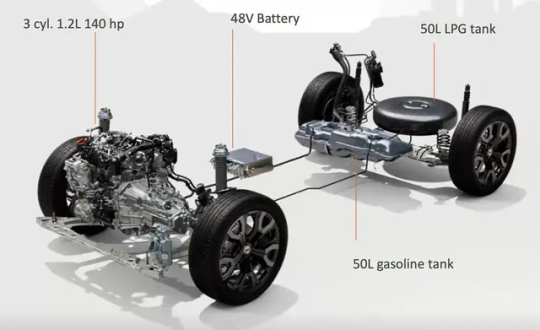
Une prouesse technique qui confirme le positionnement de Dacia comme champion du rapport qualité-prix. Dans un contexte où le coût de la mobilité et la réglementation environnementale se resserrent, Dacia continue de frapper fort avec des solutions techniques simples, robustes et accessibles. Le constructeur franco-roumain annonce une nouvelle motorisation mild-hybrid essence/GPL, destinée à ses futurs modèles phares, le Duster et le Bigster. Un choix stratégique qui promet jusqu’à 1 400 km d’autonomie cumulée, à un tarif toujours compétitif. Moins cher que le Duster 4×4 : Ce Jeep compact consomme seulement 5,4 L/100 km. L’impossible équation résolue : autonomie titanesque, empreinte écologique minimale et prix cassé pour ce SUV qui chamboule les codes. Ce 4×4 hybride familial affiche 6l/100km et 7 ans de garantie : la révolution que les familles attendaient. Cette initiative reflète parfaitement l’approche pragmatique de Dacia : proposer des véhicules modernes sans surcharge technologique, mais capables de répondre aux besoins du plus grand nombre. Une architecture ingénieuse et économique, un moteur essence couplé à un système électrique 48V et deux réservoirs (essence + GPL) assurent efficience et autonomie record sans compromis. Le système proposé par Dacia repose sur une hybridation légère 48V associée à une motorisation essence compatible GPL, le tout connecté à deux réservoirs de 50 litres chacun. Cette solution permet au véhicule de basculer automatiquement entre essence et GPL selon la situation, avec pour objectif de réduire la consommation tout en maximisant la distance parcourue

1 Dacia Spring
2 Fiat 500e
3 Leapmotor T03
9 notes
·
View notes
Text
Reflecting from the Himalayas: Our Journey as Jurors for the Materia Award 2025
This year held an extra layer of meaning for our sister firm SMA and us. Sagarmatha Next— mountaineering waste upcycling center near Everest—was officially welcomed into the Materia Award family on 22 March 2025 in Paris. Selected by a distinguished jury of 15 professionals and scientists, the project was included in both the Materia exhibition and the accompanying publication, Stone: 40 Best Contemporary Sustainable Architecture Projects in the World. Architect Himanshu Lal, a key member of the design and execution team, was in Paris to receive this international recognition on behalf of SMA, making it a super proud and reflective moment for all of us rooted in the Himalayas.

To be counted among the top 40 projects in the global Materia Award 2025 is a humbling recognition. Rooted in the spirit of place and material—so deeply aligned with the Himalayan ethos—this honor came with a beautiful invitation from Prof. Anne: to pause, reflect, and engage deeply with the other 39 selected works from around the world.
Together, as Team SMA from Kathmandu and Team HAP from Bhimtal, we also stepped into the role of Himalayan jurors, grounding our perspectives in the mountains we call home. Over days of review and deliberation, we curated our personal Top 5 from the shortlisted entries—projects that spoke not only to innovation and sustainability but to cultural continuity, the dignity of materials, and human-scale craft.

Each of the 11 jury members brought a lens informed by their local terrain and traditions. On the morning of March 26th, we came together—across regions and time zones—to listen, debate, and learn from one another. The following day, we cast our votes.
The entries stretched across climates and cultures: from Housing Now’s affordable bamboo housing solution in Myanmar, to the restoration of a barrack built with earth and thatch in El Palmar, to a rest house entirely clad in scallop shells. What unified them all was a rootedness in local context and a commitment to ecological intelligence.
After careful reflection, our collective selection of five projects stood out:
Le Costil House, France A thoughtful extension of a traditional brick house, aiming for 0% concrete, 0% plastic, and 100% natural materials—wattle-and-daub, light earth, lime plaster, and hemp—demonstrating how heritage materials can guide future architecture.
Medical Surgical Center, Burkina Faso A powerful response to resource constraints, this center uplifts local materials—adobe, straw, and laterite—while celebrating the wisdom of vernacular craftsmanship.
La Bricole, France A poetic celebration of reuse, reinterpreting reclaimed wood and hemp into a space that feels both familiar and forward-looking.
Low-Cost Housing, Sahel, Mauritania A modular, scalable housing solution by Architecture et Développement au Sahel, using Nubian vault adobe techniques.
Casa Lasso, Ecuador A grounded yet ambitious project that draws from Cotopaxi’s vernacular traditions. Built with rammed earth and local labour, it’s as much about construction as it is about community learning and continuity.
The Materia Awards invited us into an exploration—a pilgrimage of sorts—through material cultures and sustainable imaginations. What we found reaffirmed something we’ve long known in the mountains: sustainability is not a constraint—it is a path of creativity, humility, and beauty.
4 notes
·
View notes
Text
Post Human Studies: The Progress Cult
Post Human Studies as a discipline does not strictly look into the existence of species descended from homosapiens, such homo florophagi or homo radiogensis It can also involve the study of socities and cultures that emerged after Galatic Springtime and the dissolution various human polities. (Tembrem et al, 3419 GC)
One such polity that arose was the Church-State of the Progress Cult. The Progress Cult was originally centered on Alpha Centauri, one of humanity's earliest settlements outside their cradle system. It was renamed by the Cult and will be heretofore referred to as Center and Proxima B to Lux-Mundus. The Progress Cult blended all forms of temporal and spiritual power in a manner not seem since the brief establishment of the Neopapcy. It was headed by the Provost Major. They even embraced the term and self labeled as a cult.
The main tenet of the Progress Cult was the study of be information new methods by any and all means possible, as fast as possible. It was s largely Futuristic and Accelerationist society that burned brightly and briefly. The Progress Cult also advocated for the violation and abolishment of all former ethics, safety codes, and even by some radical members knowledge. It was all to be thrown out for the radical reordering of society. Proxima now known as Lux Mundus was transformed from a beautiful example of the First Wave Human Colonial Architecture to a radical avant guard style blending advances in building techniques with whatever fancy crossed the architect's mind.
The use of autofactories and other advances in robotics allowed rhe Progress Cult to exist for roughly 309 standard Earth years without the existence of a prolieterate class. While the advancement of knowledge at all costs did create some achievements that are still around today such as the rejuvenation protocols, homo florophagi, and extrasolar cows most of their creations their wunderbare Ideen have by and large been either replicated without the loss of life involved or dead ends. The Progess Cult collapsed 8 years after the death of the first and only Provost Major when their famed rejuvenation protocols finally lost their efficacy after half a millennium. After their death there were several pretenders to the title across the systems that the Cult controlled.
The Progress Cult hurtling full speed ahead at all times has consigned itself to the dust bin of galactic history.
9 notes
·
View notes
Text
Photoresponsive Shape Morphing
Movement with light: Photoresponsive shape morphing of printed liquid crystal elastomers
Michael J. Ford1 ∙ Dominique H. Porcincula1 ∙ Rodrigo Telles3 ∙ … ∙ Shu Yang2 ∙ Elaine Lee1 [email protected] ∙ Caitlyn C. Cook1,5 [email protected] …
Progress and potential
Soft matter that can adapt in response to a stimulus like light holds immense promise for various applications, such as biomedical devices and soft robotics. One example of adaptive soft matter is liquid crystal elastomer composites, which incorporate a functional additive and change shape through a phase transition. The combination of the material composition, the printed geometry of the material, and the localization of the stimulus can enable novel movement and reaction to light, as we demonstrate in this paper. Our results mark a significant advancement toward creating complex, 3D-printed, intelligent materials that pave the way for developing next-generation adaptive machines and devices that can transform in response to specific stimuli.
Highlights
•
Optimized inks for additive manufacturing of a liquid crystal elastomer composite
•
Developed spatiotemporal control during printing for complex three-dimensional structures
•
Demonstrated unique combinations of complex three-dimensional photoresponsive actuation
•
Controlled novel modes of actuation with computer vision techniques
Summary
Soft machines will require soft materials that exhibit a rich diversity of functionality, including shape morphing and photoresponsivity. The combination of these functionalities enables useful behaviors in soft machines that can be further developed by synthesizing materials that exhibit localized responsivity.
Localized responsivity of liquid crystal elastomers (LCEs), which are soft materials that exhibit shape morphing, can be enabled by formulating composite inks for direct ink writing (DIW). Gold nanorods (AuNRs) can be added to LCEs to enable photothermal shape change upon absorption of light through a localized surface plasmon resonance.
We compared LCE formulations, focusing on their amenability for printing by DIW and the photoresponsivity of AuNRs. The local responsivity of different three-dimensional architectures enabled soft machines that could oscillate, crawl, roll, transport mass, and display other unique modes of actuation and motion in response to light, making these promising functional materials for advanced applications....
Soft machines could enable new breakthroughs in technologies related to human-machine interactions, remote exploration in difficult-to-reach spaces, and individually tailored health care. These machines will require soft materials that exhibit a diverse range of functionalities, including actuation for movement, conductivity for sensing and signal processing, stimuli-responsivity, self-healing, and reprocessability.1,2,3The demonstration of such a diverse range of functionalities results in a profound outcome where “the material is the machine.”4,5 That is, by taking advantage of behaviors like self-assembly and phase transitions, these materials as machines can replace traditional sensors, transducers, gears, levers, and electromagnetic motors to enable perception, responsivity, and motion without engineered complexity.2,4
Liquid crystal elastomers (LCEs) that are pre-programmed to change shape in response to external stimuli are considered useful for soft machines.6,7 The shape morphing is induced by heat, electricity, and light.8,9Light may be useful to stimulate localized actuation and does not require physical contact with the shape-changing material, as wires that transmit electrical power might require.10,11 Localized actuation using light could also allow for unique modes of actuation.12 For example, asymmetric illumination of photoresponsive LCEs led to twisting and rolling motions.13 Peristaltic motion that resembles the movement of biological organisms has been demonstrated by using localized impingement of different patterns of light upon an LCE.14 To extend this work, the programmed order of the liquid crystal (LC) domains could be controlled and modified....
2 notes
·
View notes
Text
Alfa Romeo 6 : La berline oubliée, mais pas sans mérite

Parmi les voitures les plus méconnues d’Alfa Romeo, l’Alfa 6 occupe une place à part. Lancée en 1979 après une gestation difficile, cette grande berline ambitieuse n’a jamais réellement trouvé son public. Pourtant, derrière son échec commercial se cache une voiture intrigante, aujourd’hui appréciée comme un classique discret.
Une genèse mouvementée
Conçue dès la fin des années 1960, l’Alfa 6 était censée incarner le haut de gamme de la marque pour concurrencer des modèles comme la BMW Série 5 ou la Mercedes Classe E. Initialement prévue pour un lancement en 1973, son développement a été retardé au profit de l’Alfetta, une berline plus compacte et commercialement plus urgente. Résultat : l’Alfa 6 n’a vu le jour qu’en 1979, en plein cœur de la deuxième crise pétrolière, un contexte économique peu favorable aux grandes berlines gourmandes en carburant.
Un design discret et pragmatique
L’esthétique de l’Alfa 6 reflète les préoccupations de l’époque en Italie, marquée par des troubles politiques et des enlèvements ciblant les élites. Alfa Romeo a opté pour un design volontairement sobre, presque austère, afin de ne pas attirer l’attention. Si cette approche se voulait rassurante, elle a également contribué à rendre la voiture peu désirable sur un marché où le prestige visuel était un argument de vente clé.
Sous le capot : un V6 inoubliable
Le principal atout de l’Alfa 6 réside dans son moteur V6 de 2,5 litres en aluminium, développant 156 ch. Ce bloc, réputé pour sa sonorité mélodieuse et sa souplesse, offrait des performances honorables pour l’époque, avec un 0 à 100 km/h abattu en 9 secondes et une vitesse de pointe de 185 km/h. Si les premières versions étaient équipées d’un système de carburateurs complexe et difficile à régler, une mise à jour en 1982 a introduit l’injection électronique, améliorant à la fois la fiabilité et la consommation.
Un châssis solide, mais une conception dépassée
Partageant sa plateforme avec l’Alfetta, l’Alfa 6 bénéficiait d’une architecture de suspension sophistiquée pour l’époque : double triangulation à l’avant et essieu De Dion à l’arrière. Elle se distinguait par une direction précise et une tenue de route agile, rivalisant avec des concurrentes allemandes. Cependant, l’absence de la transmission transaxle de l’Alfetta limitait son équilibre et son raffinement global.
À l’intérieur, l’Alfa 6 offrait une ambiance élégante mais étroite, héritage de sa base technique. Les matériaux utilisés étaient de bonne facture, en particulier pour une berline italienne des années 1980, souvent critiquées pour leur finition médiocre.
Une carrière commerciale désastreuse
Malgré ses qualités dynamiques et son moteur remarquable, l’Alfa 6 n’a jamais rencontré le succès. Les ventes ont été plombées par son positionnement maladroit, son style démodé et son retard de lancement. Sur les 12 070 exemplaires produits entre 1979 et 1986, seulement 134 ont été vendus au Royaume-Uni, un marché pourtant prometteur pour ce type de véhicule.
Un classique à redécouvrir
Aujourd’hui, l’Alfa 6 est davantage considérée comme une curiosité de collection qu’une berline de prestige oubliée. Son moteur V6, toujours aussi raffiné, et son châssis bien conçu en font une voiture agréable à conduire, tandis que son faible nombre d’exemplaires produits lui confère une certaine rareté. Avec son allure discrète, elle séduit les amateurs d’Alfa Romeo à la recherche d’un modèle atypique et accessible.
Fiche technique de l'Alfa 6 (1980-1986)
Moteur : V6 2,5 litres, injection
Puissance max : 158 ch à 5600 tr/min
Couple max : 212 Nm à 4000 tr/min
Transmission : Propulsion, boîte automatique ZF 3 rapports
Performances : 0-100 km/h en 9 secondes, Vmax 185 km/h
Poids : 1470 kg
Production totale : 12 070 exemplaires
L’Alfa 6 reste une pièce singulière dans l’histoire de la marque, une voiture qui incarne à la fois l’ambition et les défis auxquels Alfa Romeo a dû faire face à une époque troublée.
3 notes
·
View notes
Text
⚡SEO ou SEA : quelle stratégie choisir ?
➡️ Le SEO améliore le classement d’un site via un contenu optimisé, une bonne architecture et des liens entrants. Cette stratégie est progressive mais assure une visibilité durable et renforce la crédibilité.
➡️ Le SEA permet d’acheter des annonces (Google Ads) pour une visibilité immédiate et un ciblage précis. Mais il nécessite un budget constant, et son impact cesse dès l'arrêt des campagnes.
💡 Vous ne savez pas quelle stratégie adopter ? Alors découvrez l’article complet et trouvez la stratégie adaptée à vos besoins…
#seo#sea#référencement#optimisation#site#web#agence web#référencementnaturel#référencementpayant#stratégiedigitale
2 notes
·
View notes
Text
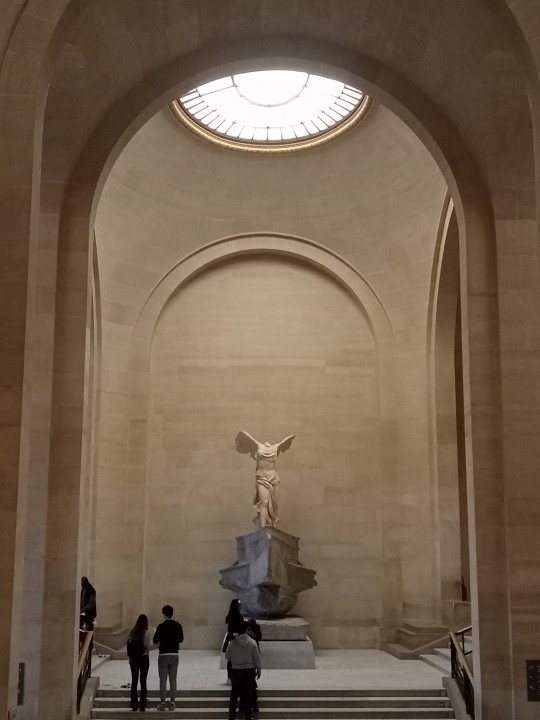
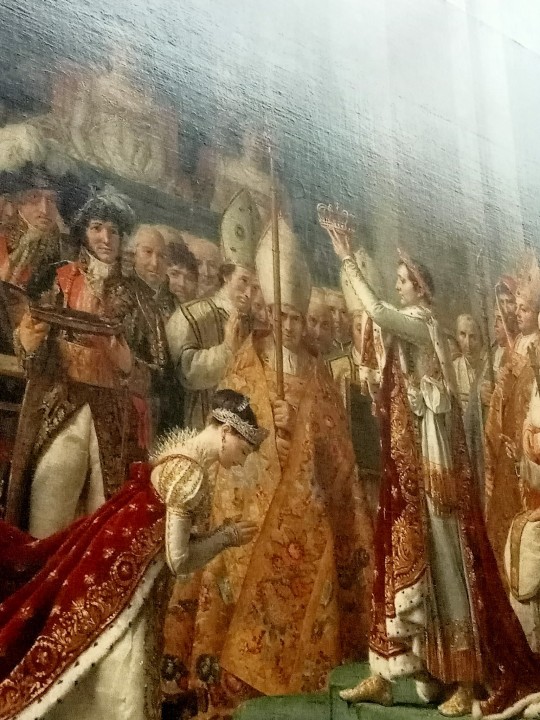
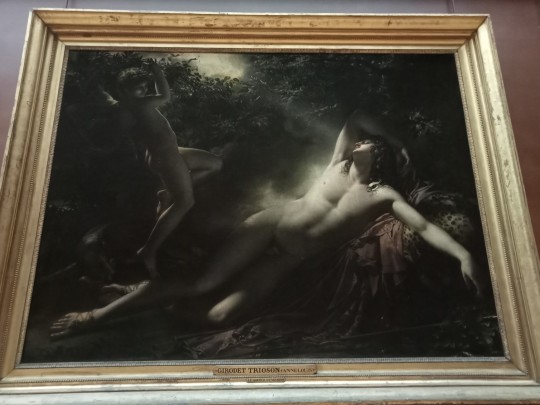
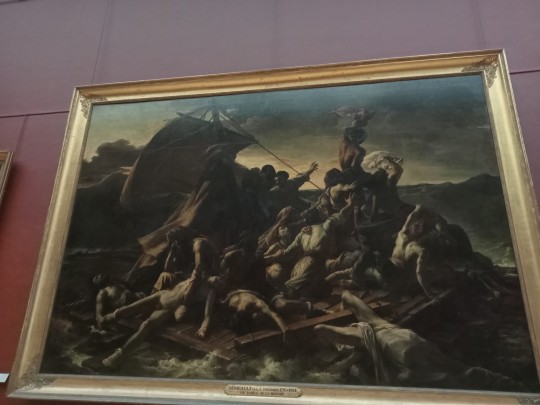
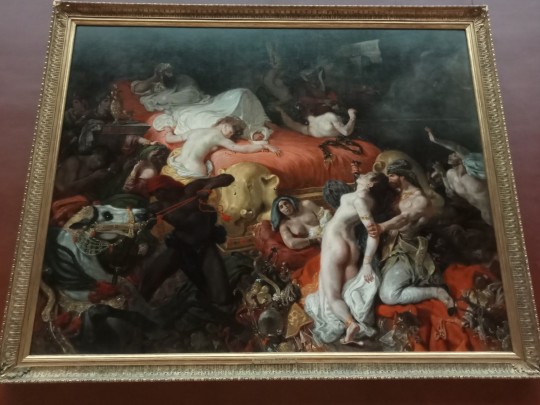
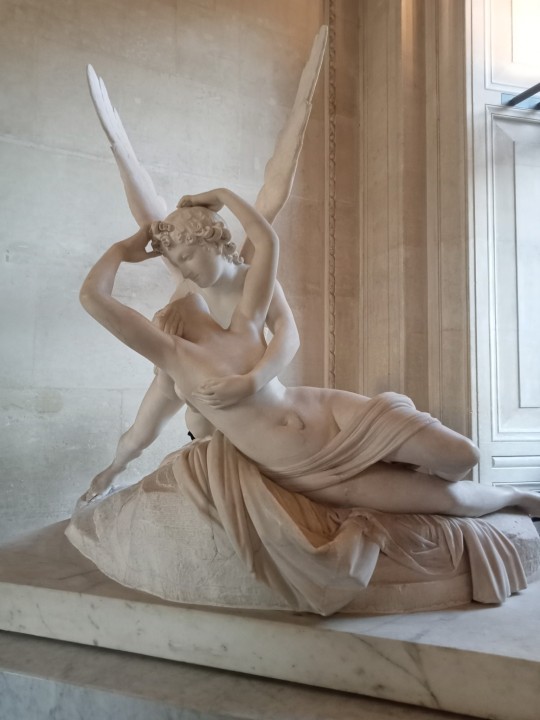
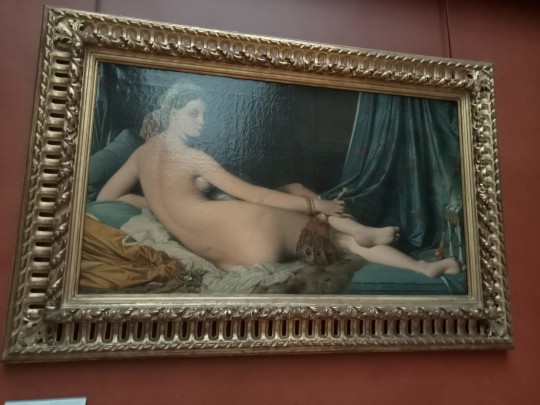
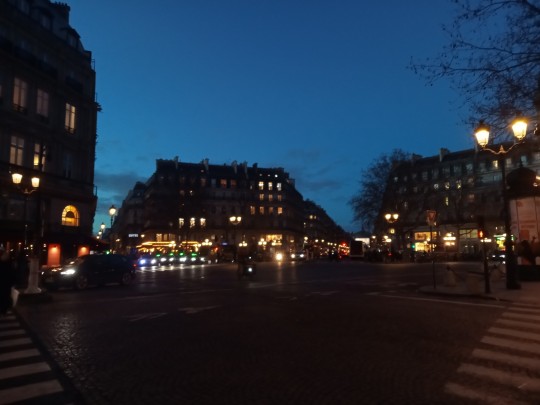
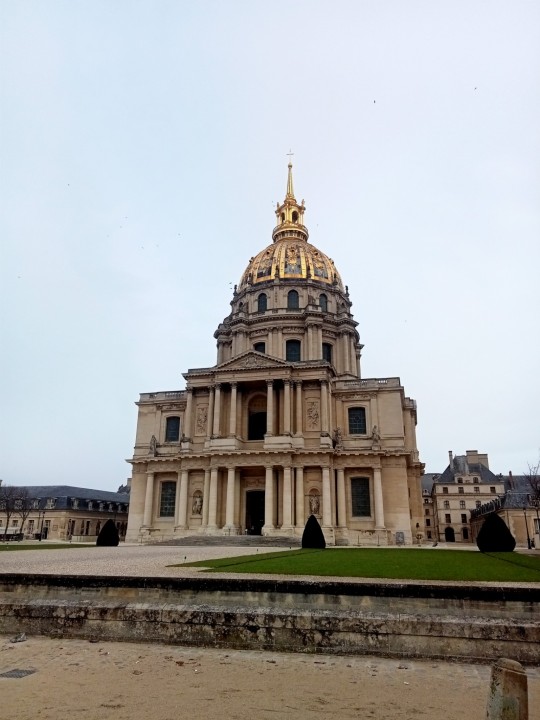
Pendant 4 jours je me suis noyée au milieu d'oeuvres d'arts. J'ai compris que les musées faisaient partis des lieux qui faisaient taire ma tête. Le monde est en suspend. Comme au cinéma mais cette fois ci je n'ai ressenti qu'une joie immense que de pouvoir enfin voir de mes yeux des oeuvres dont on me parle depuis enfant. Me rapprochant le plus possible de chaque tableau afin d'en admirer la texture, la technique, en faisant le tour des statues. Je dois être un enfer pour les gens qui m'accompagne parce que j'y passe beaucoup de temps, mais visiblement mon copain l'a accepté puisque mon sourire béat et un peu gaga le rendait heureux.
Bref. J'ai de nouveau de l'inspiration pour dessiner et tenter des choses, j'ai encore un peu de temps avant la reprise des cours donc je vais vraiment essayer de faire ça et puis, retourner faire des sorties musée à Strasbourg même seule, ça peut être chouette d'essayer de dessiner quelques oeuvres.
Bref. Paris reste une ville qui pue, qui n'est pas très organisé mais la quantité d'art ( architectural et arts ) est incroyable.
J'ai mal aux pieds,je suis crevée mais qu'est ce que c'était bien.
Par contre le retour a la maison a signé mon retour sur insta et ça c'est nul. Je vais tenter au max d'éviter de regarder les stories des gens parce que c'est déprimant.
Voilà voilà
10 notes
·
View notes
Text
5 Conseils Incontournables pour Optimiser le SEO de Votre Site Web en 2024

L'optimisation pour les moteurs de recherche (SEO) est essentielle pour améliorer la visibilité de votre site web. En 2024, avec les mises à jour des algorithmes de Google et l'importance croissante de l'expérience utilisateur, il est plus que jamais crucial de maîtriser certaines techniques pour assurer une bonne performance en ligne. Cet article vous présente 5 conseils incontournables pour optimiser le SEO de votre site et attirer plus de visiteurs.
1. Priorisez l'Expérience Utilisateur (UX)
L'expérience utilisateur est devenue un facteur clé dans le référencement. Les moteurs de recherche privilégient les sites qui offrent une navigation fluide et un contenu pertinent.
Optimisez la vitesse de chargement de vos pages.
Assurez-vous que votre site est responsive (adapté aux mobiles et tablettes).
Facilitez la navigation avec des menus simples et une architecture claire.
2. Utilisez des Balises Meta Optimisées
Les balises meta, comme les titres et les descriptions, restent des éléments fondamentaux pour le référencement. Ces balises aident les moteurs de recherche à comprendre de quoi traite votre contenu.
Rédigez des titres captivants et concis, contenant vos mots-clés principaux.
Créez des meta descriptions attrayantes, incitant les utilisateurs à cliquer.
3. Investissez dans un Contenu de Qualité
Le contenu est roi, et en 2024, la qualité prime sur la quantité. Les moteurs de recherche valorisent les contenus bien structurés et utiles pour les utilisateurs.
Créez des articles longs et détaillés qui répondent aux questions de votre audience.
Utilisez les bons mots-clés, mais sans en abuser (évitez le keyword stuffing).
4. Optimisez pour la Recherche Vocale
Avec la montée en puissance des assistants vocaux, il est important de penser à la recherche vocale. Les utilisateurs formulent leurs requêtes différemment lorsqu’ils parlent.
Utilisez des phrases plus naturelles et des questions dans vos contenus.
Structurez vos articles pour répondre directement à des questions fréquentes.
5. Renforcez Votre Stratégie de Backlinks
Les backlinks sont un signal fort pour les moteurs de recherche. Plus vous avez de liens entrants provenant de sites de qualité, mieux votre site sera classé.
Collaborez avec d'autres sites pour échanger des backlinks.
Publiez des articles invités sur des blogs pertinents pour votre industrie (comme cet article !).
Conclusion :
L'optimisation SEO en 2024 nécessite de rester à jour avec les dernières tendances et techniques. En suivant ces 5 conseils, vous mettrez toutes les chances de votre côté pour améliorer la visibilité de votre site. Si vous souhaitez un accompagnement professionnel dans la création ou l'optimisation de votre site web, faites confiance à Simply Design, une agence spécialisée dans la création de sites web performants et leur optimisation SEO.
Visitez Simply Design pour en savoir plus sur nos services.
#agence seo#search engine optimisation#seo optimisation#référencement naturel#référencement SEO#SEO#seo services
2 notes
·
View notes
Text
Les Civilisations Paléomagos
La découverte pour les humains du monde magique suite à l’Événement de Stonehenge ne fut pas le seul choc majeur qui suivit l’Éveil de la Magie.
Les multiples barrières de dissimulations tombées révélèrent également les Mers, que même les magus avaient oubliés… mais surtout de multiples ruines à travers le monde, prédatant toutes les civilisations connues!
Ces ruines, il s’avéra vite, étaient les vestiges des civilisations Paléomagos, peuples d’Homo Magicus vivant durant le Mésolitique, et ayant disparu au Néolithique.
Ces civilisations faisaient toutes un grand usage de magie, à un niveau équivalent, voire parfois supérieur au niveau de connaissance et de maîtrise de la magie actuel, et même un niveau technique et culturel proche des Homo Sapiens durant l’Antiquité. De plus, l’usage de magie fait que ces civilisations pouvaient voyager et communiquer à travers le monde avec une facilité qui ne sera plus vue jusqu’à la Révolution Industrielle. Même si on avait perdu tout souvenir d’elles, ces civilisations avaient clairement laissé leur trace dans l’Histoire, puisqu’on trouve encore, des millénaires après leur disparition, des vestiges de leur culture dans les civilisations humaines ayant suivi.
Liste des Civilisations Paléomagos:
Agartha
localisation : Ouest Asie, principalement dans l’Himalaya jusqu’en Inde et au Népal mais également jusqu’en Mongolie et en Ouzbékistan langue : Samskrtam Agarthan écriture : Siddham Agarthan style architectural : rappelant des temples hindous Il s’agit d’une civilisation presque entièrement souterraine, si bien que les ruines auxquels on a pu avoir accès sont très bien préservées. En contrepartie, la découverte et l’accès à ces ruines est parmi les plus compliqués.
Les Agarthans étaient un peuple vivant relativement isolé, ne faisant que peu de commerce, et très spirituel, cherchant à se rapprocher toujours plus de l’essence de la magie. C’est probablement pour cela qu’ils vivaient sous terre, cherchant à se rapprocher plus des points telluriques où la magie était la plus puissante, mais aussi la plus instable. Leur utilisation de la magie s’appuyait largement sur les gemmes taillées, faisant de leurs zones magiques des œuvres d’art étincelantes.
Avalon
localisation : Europe du Nord-Ouest, de l’Islande à la Bretagne et de l’Irlande jusqu’en Suède langue : Gaelg Avalonan écriture : Ogham Avalonan style architectural : rappelant du celte et viking Les Avalonans était un peuple très spirituel, mais ouvert aux autres cultures dans son ensemble. Religieux, la divinité principale de leur panthéon était une déesse de la Magie et de la Flore. Ils construisaient donc énormément en symbiose avec la nature. Leurs ruines ne sont pas faciles à trouver, car les constructions les plus durables sont enfouies pour se rapprocher des lignes telluriques, tandis que le reste était fait pour être difficilement différenciable de la nature. Des recherches à Stonehenge ont révélé que le site avait été bâti au-dessus d’une place religieuse Avalonane, d’où l’Événement de Stonehenge a probablement été déclenché d’une manière ou d’une autre… Les écrits à travers le monde semblent s’accorder pour dire que les Avalonans étaient un peuple ayant un don pour la Divination inné.
Atlantis
localisation : Bassin méditerranéen langue : Ellinika Atlantida écriture : Alfavito Atlantida style architectural : rappelant du style gréco-romain antique Peu de ruines ont pour l’instant été explorés, car cette civilisation possédait probablement les barrières les plus sophistiquées, difficiles à désarmer et dangereuses à forcer. Des rares ruines ouvertes, il est clair qu’ils sont l’influence principale derrière l’architecture gréco-romaine. Ils paraissaient avoir une approche quasi scientifique de la magie, n’ayant quasiment aucune notion de religion et étaient très commerçants. Ils ont probablement créé les fondamentaux de l’Arithmancie.
Hyperborea
localisation : de la Suède jusqu’en Corée, couvrant principalement la Russie et l’Europe de l’Est langue : Hyperboroi Yazik écriture : Cyril Hyperboreal style architectural : rappelant les fort militaires XVIIe siècle C’était un peuple martial, très ordonné, voyant plutôt d’un mauvais œil ceux s’intéressant de trop près aux lignes et points telluriques, car ils étaient considérés comme trop dangereux, puisque la magie environnante en est plus puissante, mais surtout plus instable. Ils commerçaient assez peu et ont provoqué des conflits avec la plupart de leurs voisins. Les rares ruines identifiées pour l’instant étaient toutes des forts, massivement fortifiés aussi bien magicalement que physiquement, ayant probablement inspiré les premiers châteaux au Moyen Âge et confirmant leur côté très belliqueux.
Iram
localisation : Moyen-Orient, de la Turquie à l’Éthiopie, de la Libye au Pakistan langue : Iram-Gi écriture : Cuneis Irami style architectural : rappelant Pétra et les villes troglodytes Tout aussi commerçants que leurs voisins Atlantes, les Iramis avaient en revanche une approche bien plus artistique de la magie, et sont ceux qui ont laissé le plus de recueils écrits de l’époque dans leurs ruines. En outre, la désertification de la région a enfoui nombre de ruines, les rendant difficiles à retrouver. C’était un peuple troglodyte, rendant leurs ruines d’autant plus délicates à retrouver, mais le travail fait dans les montagnes et autres ravins où on a retrouvé leurs traces est absolument époustouflant.
Lemurie
localisation : Sub-Sahara et Océan Indien langue : Al’Lemuria écriture : Abjad’ Lemuria style architectural : navires de tous types
On ne sait que peu de choses des Lemures, car très peu de ruines ont été retrouvées. Cependant, tout indique que c’était un peuple de marins, très doué en astronomie et vivant plus en mer qu’à terre, leurs navires ayant été de vraies villes flottantes. Malheureusement, cette vie sur l’eau fait que presque tout a été perdu de leur civilisation, à l’exception de quelques restes très dégradés par le temps. Cependant, les rumerus veulent qu’il existe encore certains de leurs navires, si bien protégés qu’ils n’ont pas encore été retrouvés, et que ce seraient eux qui sont à l’origine de la plupart des légendes de navires fantômes.
Mu
Localisation : Amérique du Nord, mais également Nouvelle-Zélande et Australie langue : Tjukurrpa-Kapi écriture : Tjukurrpa-Waru style architectural : rappelant les ruines Incas
Ayant entretenu des liens étroits avec les Avalonans, le peuple de Mu avait une civilisation similaire, mais donnant la part belle à la Faune plutôt qu’à la Flore, et que leurs temples n’étaient pas sous terre mais au cœur des montagnes. Il est fort probable que les premiers Bestiamihis viennent de cette civilisation.
Tiwanaku
localisation : Amérique du Sud et Centrale langue : Tsagali Mu écriture : Sequoyah Mu style architectural : rappelant les ruines mayas C’est le seul peuple dont des ruines ont été découvertes avant même l’Événement de Stonehenge, bien que, bien entendu, personne à l’époque n’ait cru à la datation qui paraissait fantaisiste des lieux. C’est peut-être le peuple le plus différent, cherchant au contraire à s’élever vers les cieux en s’établissant sur de hauts plateaux montagneux plutôt qu’à vivre sous terre comme le faisaient nombre de leurs contemporains. Ils pratiquaient énormément la magie rituelle, et sont l’exemple typique que l’on donne pour prévenir des dangers de la magie noire : on pense en effet que cette civilisation s’est écroulée avant les autres suite à une pratique trop intensive de rituels dangereux, ayant rendu une bonne partie de leur civilisation folle ou corrompue.
Yamatai
localisation : Japon, Chine et Asie du Sud-Est langue : Yamatai Guo écriture : Kan Yamatai style architectural : rappelant les châteaux japonais Cette civilisation était probablement la plus isolationniste, n’ayant quasiment pas de liens avec les autres peuples de l’époque et se contentant de commerce interne. Ils avaient une bonne maîtrise des rituels, et des lois très strictes à ce sujet pour éviter les cas de corruption et de folie.
C’était également un peuple spirituel, respectueux de la magie qu’ils possédaient et tout à fait conscient de sa dangerosité. Là encore, leur architecture a été adoptée, d’abord part les Youkais, puis par les populations non magiques de la région bien plus tard.
#hippogryphe saoul#jeu de role#H2S lore#ttrpg#les héritiers de l'hippogryphe saoul#H2S#jeu de rôle#jdr#rpg#tabletop rpg#modern fantasy#urban fantasy#fantasy
1 note
·
View note
Text
Brain Exercise Text #3 for Akhenaton (@AkhenatonIAM) and Vincent Callebaut (@vincentcallebautarchitectures): (July 07, 2025)
Sujet : L’importance d’intégrer une gare et des autoroutes dans le projet du "Las Vegas alsacien"
""""La gare de Hausbergen""""
Quand on conçoit une ville nouvelle aussi ambitieuse que le Las Vegas alsacien, il ne suffit pas seulement de penser aux bâtiments, aux casinos ou aux quartiers résidentiels. Il faut aussi penser à comment les gens vont y arriver et comment ils vont se déplacer une fois sur place. C’est ce qu’on appelle l’infrastructure de transport. Et dans ce domaine, deux éléments sont essentiels : la gare et les autoroutes.
1. Pourquoi une gare est-elle indispensable ?
Une gare, ce n’est pas simplement un lieu où l’on prend le train. C’est un centre de connexion stratégique. Si vous prévoyez que votre future ville accueille jusqu’à 40 millions de touristes par an — comme c’est le cas pour la vraie Las Vegas aux États-Unis — alors vous devez absolument penser à un moyen efficace, rapide et fiable pour amener tous ces visiteurs jusqu’à vous.
C’est ici qu’intervient la gare de Hausbergen, située non loin de Strasbourg. Elle pourrait devenir un point d’arrivée majeur pour les touristes venant en TGV depuis Paris, Lyon, Marseille, Bruxelles, ou même l’Allemagne et la Suisse. Cependant, cette gare n’est pas encore dimensionnée pour recevoir un tel flux. Il faudra donc l’aménager, l’agrandir et la moderniser afin qu’elle puisse :
accueillir des trains à grande vitesse plus fréquemment ;
fluidifier l’arrivée massive de voyageurs ;
offrir des connexions efficaces vers le futur Las Vegas alsacien (navettes, tramways, taxis, etc.).
2. Pourquoi intégrer aussi des autoroutes ?
Les trains ne sont pas le seul moyen de transport. Beaucoup de touristes voyageront en voiture, en autocar ou en véhicule de location. Pour cela, il est crucial d’intégrer un réseau autoroutier bien pensé, qui :
connecte facilement la ville à Strasbourg, à l’Allemagne, et aux grandes villes françaises ;
évite les embouteillages et facilite l’accès rapide aux hôtels, casinos et attractions ;
permet aux professionnels (livraisons, travailleurs, partenaires logistiques) de circuler efficacement.
3. Conclusion : penser mobilité, c’est penser succès
En résumé, pour que le Las Vegas alsacien devienne une réalité prospère et fonctionnelle, la mobilité des personnes et des biens doit être au cœur du projet.
Une gare bien aménagée comme celle de Hausbergen, modernisée pour accueillir les TGV et les millions de visiteurs.
Un réseau autoroutier bien dessiné pour fluidifier l’accès et garantir la sécurité.
C’est cela qui fera la différence entre un rêve architectural et une véritable réussite économique.
Voici le lien Wikipédia mentionné dans ce texte, concernant la gare de Hausbergen :
🔗 Gare de Hausbergen — Wikipédia - (Cliquez sur le lien)
Ce lien vous permet d’accéder à toutes les informations techniques et historiques sur cette gare, située dans le Bas-Rhin (Alsace), et qui pourrait jouer un rôle clé dans votre projet du Las Vegas alsacien. Pensez à consulter les sections sur :
la localisation géographique,
les connexions ferroviaires actuelles,
son potentiel d’agrandissement.
P.S:
Cliquez sur la photo pour la voir en grand. Étudiez la géographie !

0 notes
Text
Comment le Centre Pompidou francilien transforme-t-il Massy en 2026 ?

Un projet culturel et architectural majeur à Massy
Le Centre Pompidou francilien, dont l’ouverture est prévue à l’automne 2026 à Massy, marque une étape décisive pour la ville et la région. Ce site de 30 000 m², baptisé « Fabrique de l’art », regroupera les réserves du musée national d’art moderne et du musée national Picasso-Paris, permettant la conservation et la restauration de plus de 120 000 œuvres d’art moderne et contemporain dans des conditions optimales. L’architecture, signée PCA-Stream, s’inspire de la célèbre « chenille » du Centre Pompidou parisien conçue par Renzo Piano et Richard Rogers, tout en s’intégrant harmonieusement au parc de la Blanchette et à son lac, offrant ainsi un dialogue entre patrimoine culturel et environnement naturel.
Des espaces ouverts et une programmation innovante
Au-delà des espaces techniques dédiés à la conservation et à la restauration, le Centre Pompidou francilien proposera une programmation culturelle riche et variée, incluant expositions, ateliers, rencontres, spectacles, projections et performances. Les visiteurs pourront également découvrir les métiers de l’art et de la création grâce à des espaces de médiation accessibles à tous. Une cafétéria et une terrasse, ouvertes sans billet, renforceront l’accessibilité et l’attractivité du site, faisant du centre un véritable lieu de vie pour Massy et ses environs.
Un levier d’attractivité pour le territoire et le marché immobilier
L’arrivée du Grand Paris Express, avec une station de la ligne 18 à seulement 200 mètres du centre, facilitera l’accès au site depuis toute l’Île-de-France et au-delà, notamment grâce à la connexion avec la ligne 14 et l’aéroport d’Orly. Cette accessibilité renforcée, couplée à l’implantation d’un équipement culturel d’envergure, dynamise l’image de Massy et favorise la valorisation de son marché immobilier. Les prix au mètre carré à Massy connaissent déjà une évolution positive, et la demande pour des biens situés à proximité du parc de la Blanchette ou du futur centre culturel devrait s’intensifier dans les prochaines années.
Un engagement collectif et une dynamique locale forte
Le projet du Centre Pompidou francilien illustre la capacité des collectivités locales, de la région Île-de-France et de l’État à collaborer pour offrir un équipement structurant au territoire. Les financements conjoints et l’implication des acteurs locaux témoignent d’une volonté partagée de faire rayonner la culture au cœur de l’Essonne et du Grand Paris. Les visites de chantier organisées pour le public traduisent aussi cette volonté d’ouverture et de dialogue avec les habitants.
Le conseil de l’agence immobilière Nicolas Immobilier
Pour les propriétaires et futurs acquéreurs, l’ouverture du Centre Pompidou francilien représente une opportunité unique de valorisation patrimoniale. L’agence immobilière Nicolas Immobilier, experte du secteur, recommande de réaliser une estimation gratuite à Massy afin de bénéficier d’une vision précise de l’évolution du marché. Grâce à une parfaite connaissance des prix m2 à Massy et à une approche humaine et personnalisée, Nicolas Immobilier accompagne chaque projet dans ce contexte de transformation urbaine, faisant de Massy une référence incontournable pour vivre, investir ou s’installer en Île-de-France.
0 notes
Photo

Modèle de plan d’affaires pour une plateforme de banque digitale, néo-banque Modèle de plan d'affaires pour une plateforme de banque digitale (néo-banque) : 1. Résumé exécutif 2. Description de l'entreprise - Mission et vision - Objectifs à court et long terme - Structure juridique 3. Analyse de marché - Tendances du secteur bancaire digital - Public cible - Concurrents directs et indirects - Avantages concurrentiels 4. Produits et services - Compte courant digital - Cartes de paiement innovantes - Épargne et investissements - Crédits et prêts instantanés - Services de change et transferts internationaux - Outils de gestion budgétaire 5. Stratégie marketing et ventes - Positionnement de la marque - Canaux d'acquisition clients - Stratégie de fidélisation - Partenariats stratégiques 6. Technologie et opérations - Architecture technique - Sécurité et protection des données - Intégration avec des fintechs https://fr.fintechpolicies.com/produit/modele-de-plan-daffaires-pour-une-plateforme-de-banque-digitale-neo-banque/?utm_source=tumblr&utm_medium=social&utm_campaign=fintech+policies+templates
0 notes